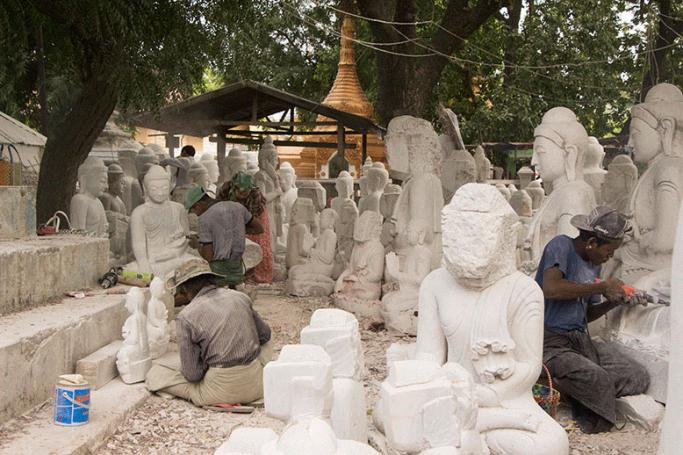For centuries, villagers at the foot of a hill in Mandalay region have carved a life out of stone.
About 30 km north of the former royal capital, the village called “Sagyin", which means “marble” in Myanmar, has become a large production base for more than 5,000 families.
“There are 7 hills surrounding our village. Most of the families here survive on making Buddha statues. I spent 5 years learning the craft in my childhood,” said Ko Myat Khin, who has worked in the industry for more than 13 years.
However there is a problem, most of the crafters in Sagyin don’t have the dust guards although the white dust always shrouds their face during work time.
Unlike farmers, who are at the mercy of each harvest season's ups and downs, the only thing these crafters need to care about is keeping in contact with their customers -- normally wealthy donors or dealers, occasionally there will be orders directly from temples. The business keeps villagers busy all day, sometimes even through the night. But, with continued exposure to dust in the smoke-filled environment, some crafters feel are concerned about their health.
“Some people who don’t have good immunity [to the dust] become sick,” Ko Myat Khin said. But he also admitted that he never thought about wearing dust guards or other masks, “because I haven’t seen anyone wearing them.”
Ko Myat Khin told us he specialises in carving the decorative pattern on medium Buddha statues. One statue usually takes him 4 days and he can earn 50,000 kyats.
Near his booth, many semi-finished statues are packed on a truck to ship to Mandalay. Most of them will arrive at the famous “Marble Street” in the downtown area.
Next to the Mahamuni Pagoda, “Marble Street” is the centre for Mandalay’s marble merchants. White Buddha statues are piled up at the roadside everywhere and many young drafters squat on the ground to use drills carving the patterns.
Carving workshops in the street began to thrive in the early 1990s as production increased with the help of electric tools and the number of workshops has now tripled to more than 60.
Compared to Sagyin village, the only difference is these workshops are equipped with electric fans — although they are very simple and not often turned on.
“After work, I often eat some bananas to help me purify the bronchus,” one worker said.
“Sometimes I feel concerned about my chest,” another craftsman said. But he didn’t consider this a big problem. “We are engaging in a good job, and the Buddha will bless us.” He added.
You are viewing the old site.
Please update your bookmark to https://eng.mizzima.com.
Mizzima Weekly Magazine Issue...
14 December 2023
Spring Revolution Daily News f...
13 December 2023
New UK Burma sanctions welcome...
13 December 2023
Spring Revolution Daily News f...
12 December 2023
Spring Revolution Daily News f...
11 December 2023
Spring Revolution Daily News f...
08 December 2023
Spring Revolution Daily News f...
07 December 2023
Diaspora journalists increasin...
07 December 2023
Dump trucks join commercial vehicle rally in support of the NLD












